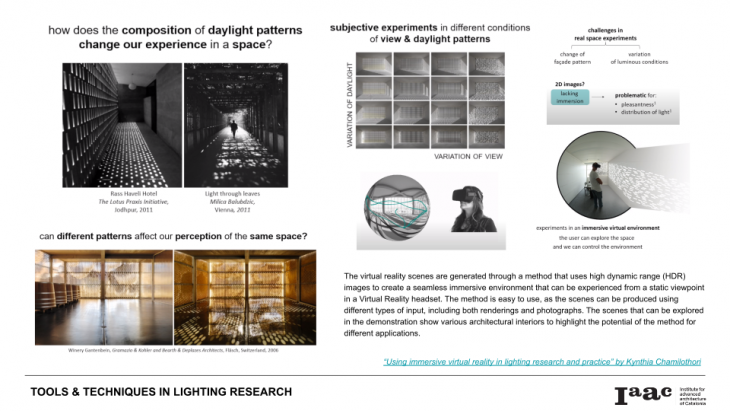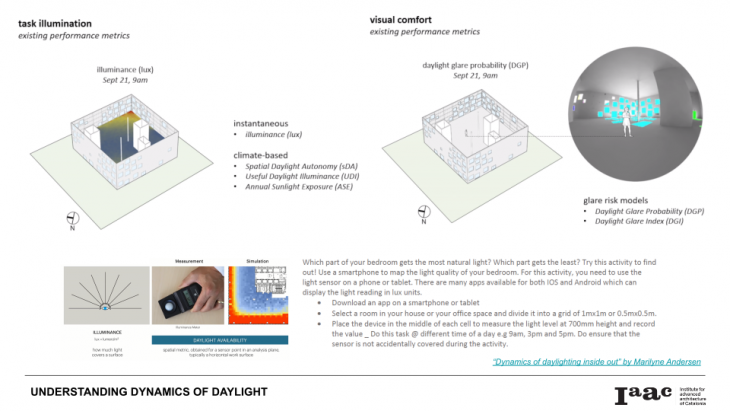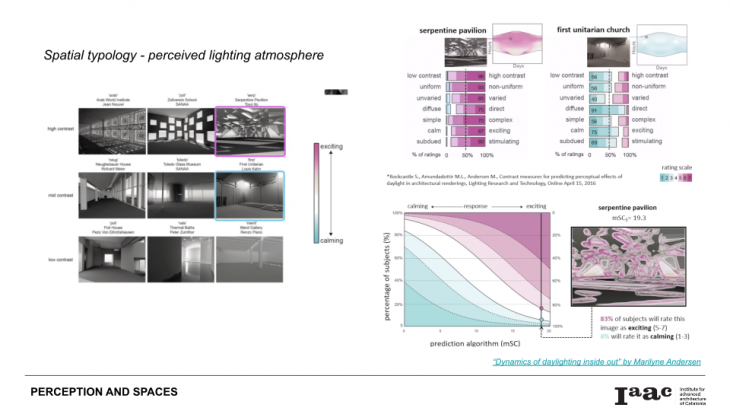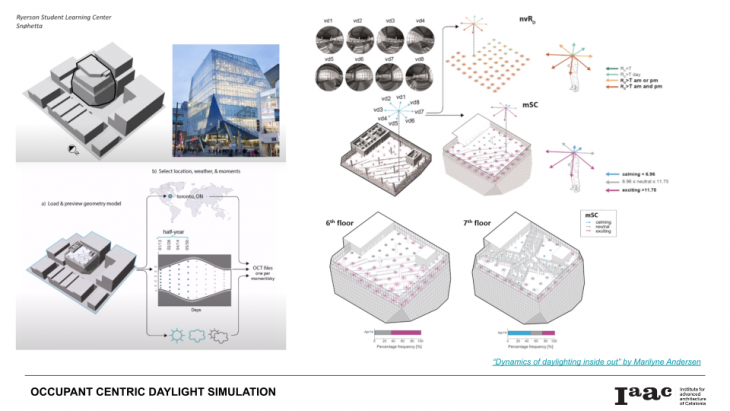//ABSTRACT:
Light – how can it help in translating these definitions into design practice and improve the architectural performance of the space. Daylighting is by nature a multi-dimensional dynamic quality in a space, which influences visual interest, enables visual performance and has physiological and behavioral impacts on the space’s occupants. All these effects need to be brought together to lead to a satisfying space design and experience with the best balance.
DAYLIGHT AND ITS APPLICATION IN DESIGN (HEALTH, COMFORT AND WELLBEING)
Design and operation criteria should negotiate multifaceted phenomena of light, air, sound and heat, offering opportunities to dynamically adjust priorities based on the variable needs of buildings and their users and the sustained needs of health and well-being over longer timeframes.
HOW TO DESIGN BUILDINGS WITH COMFORT, HEALTH & WELLBEING?? 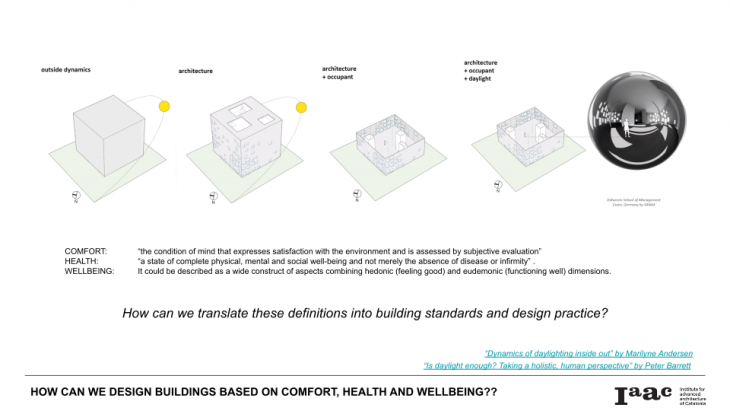
IMPACT AND BENEFITS OF DAYLIGHT ON HUMAN WELLBEING
Vision is one of the most complex and energy intensive functions of our bodies and it accounts for the dynamic contribution of all sources of direct and reflected light. Reflections off surfaces also determine the colour and distribution of light within a space. Shadows and sparkle can influence mood. Given this, the easiest way to achieve locally appropriate circadian stimulus inside of buildings is via naturally daylit spaces.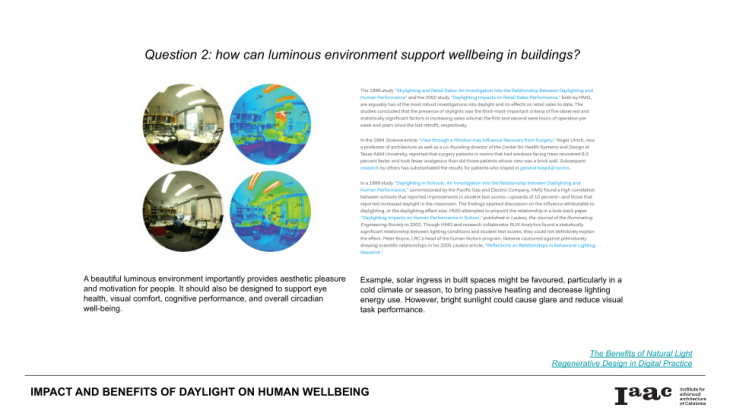
IMMERSIVE DAYLIGHT PERFORMANCE APPROACHES
Lone Wiggers gives examples of buildings such as The Medical Faculty Building, that integrates daylight and nature into the development of modern hospital design. The intelligent buildings with this built-in sustainability for the users can physically and ultimately have an impact on people’s happiness. Other example includes emotionally supportive spaces designed with the focus on daylit, passive design strategies incorporating local fabrication methods at maternity waiting village by MASS Design Group.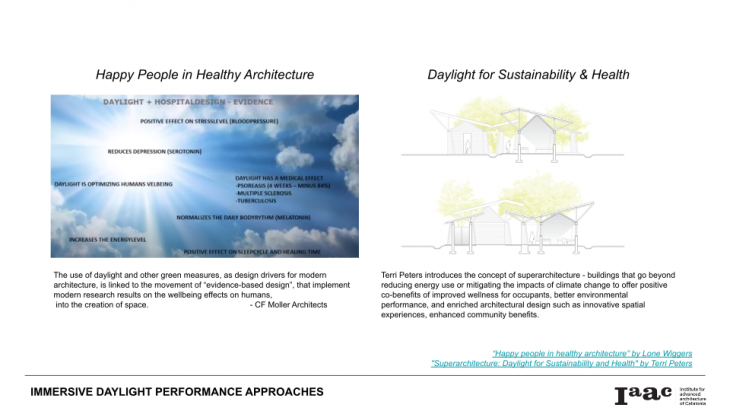
//LIGHT AND IT’S ARCHITECTURAL ASPECTS:
LIGHT AS A QUALITATIVE ASPECT IN DEVELOPING ARCHITECTURE || Project by Stefan Bennisch – Shift from transparency to immateriality aspect of light – COMPETITION – In a historic hall, building should not disturb hall but should double the space in the hall and it shouldn’t be there. Working with The reflections was the idea – historic building in perceived in the inside and new building on the outside through the walls. Also, a project by Glenn Murcutt, southern façade perfectly articulated with windows, fins to low sun angle for the comfort of the spaces.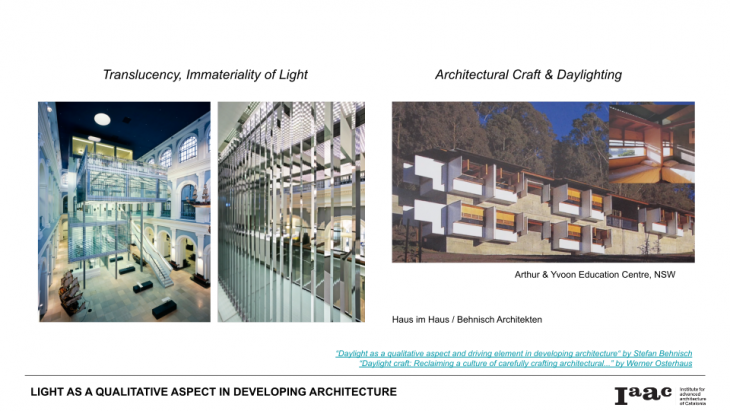
LIGHT AS A QUALITATIVE ASPECT IN DEVELOPING ARCHITECTURE || Work by James Carpenter – An observation platform within the building, here there are sky blue rectangles printed on inside glass surface and outside is the mirrored rectangle, so when one looks from outside, the mirror reflects sky and nature behind them – fragmentation of nature imprinted on the skin of the building – like sky jumped from outer surface to the inner structure – working with blue reflective and direct natural light to create an active environment.
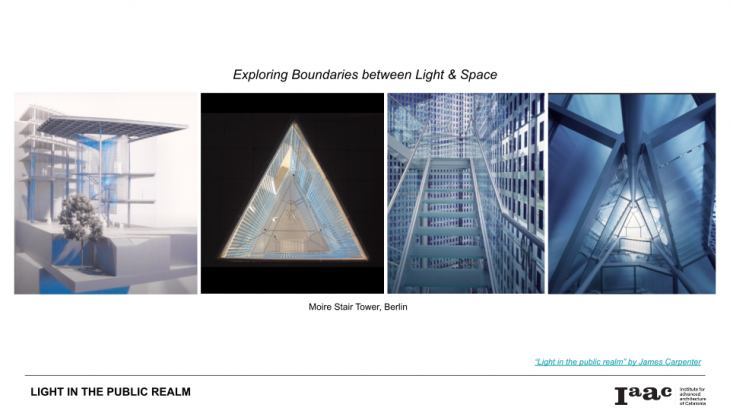
LIGHT AND SENSATION – VISUAL ASPECTS || Dr laura Johson uses Light and its power to transform space, specialising in the application of materials that reflect and transmit light in various ways and change during the course of a day. Building users often refer to the positive impact this sense of change brings to such spaces.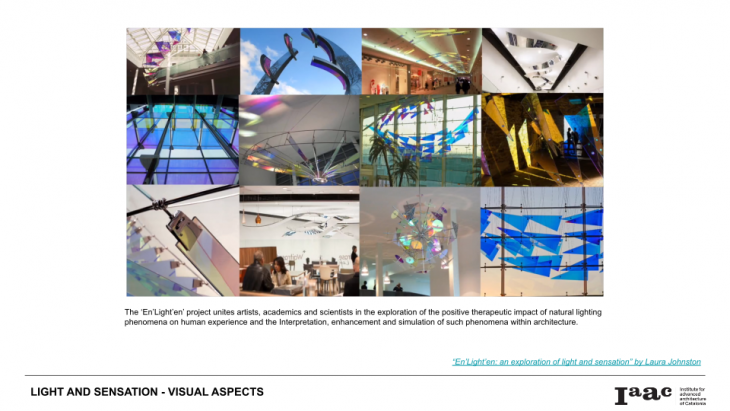
//TOOLS & TECHNIQUES IN LIGHTING RESEARCH:
This research is To understand change in human perception and experience of space due to different daylight patterns using virtual reality scenes through a method that uses high dynamic range (HDR) images to create a seamless immersive environment that can be experienced from a static viewpoint in a Virtual Reality headset. The scenes that can be explored in the demonstration show various architectural interiors to highlight the potential of the method for different applications.
UNDERSTANDING DYNAMICS OF DAYLIGHT ||Here are just some basics of daylight and the mini-exercise. To understand the lighting levels within my space and its impacts. Aspects looked into are task illumination and visual comfort.
A SIMPLE EXPERIMENT – UNDERSTANDING QUANTITATIVE ASPECTS|| A case study that involved studying lux levels in a bedroom and adjacent bathroom at three times of the day – 6am, 12 noon and 6 pm over different days with sunny/overcast/cloudy skies. Task illumination is very crucial– Bathroom only limited period daylight – else artificial light which is not optimum.
Minimum 300 lux is required in any space. There is an irregular distribution. Again bedroom – requires around 100-150 lux on average during day. Mostly used during night. But very high around 500lux not optimum for afternoon sleep. Study task require min 300-500 lux. Quite low in that space during the entire working period. Hence, needs task lighting.
In the bathroom, there is visual comfort due to lack of glare. But only limited hours of natural comfort daylight. The bedroom – optimum direct light except discomfort during afternoon hours. Study area has maximum discomfort due to darkness except during early morning hours – diffused light. 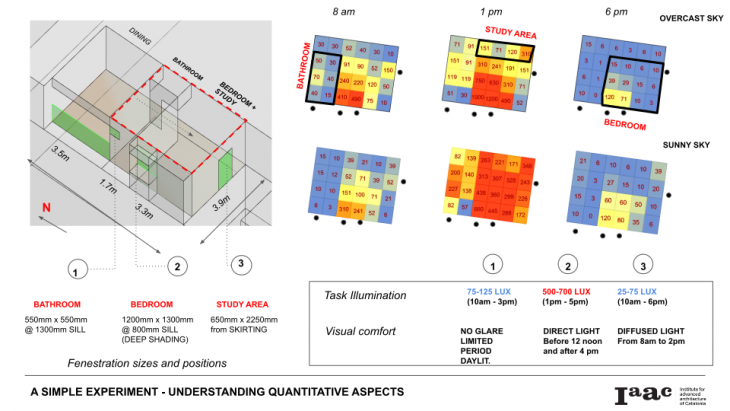
A SIMPLE EXPERIMENT – UNDERSTANDING QUALITATIVE ASPECTS|| Further simulation analysis gives similar results for the bedroom and bathroom areas proportionately in terms of lux levels. However, the results for the study area are contrasting. This maybe due to manual error in luxmeter calc or building context modelling in simulation software.
Meanwhile, the window to floor ratio for the bedroom and study together reach the optimum level of 20%. What could to be taken care of is the window head height so that light reachs upto 1.5 to 2 times of that along the depth of the space. Whereas in bathroom, there are limitations in height of window. Hence, more reflection within the space should be taken care of.
The daylight autonomy studies show that the adequate lux levels are met in most of the spaces except the bathroom. This is in period of 6am to 6pm. The ADE and SDA levels suggest good visual comfort due to less glare and overheating but yet the optimum lighting is not achieved by all parts of the space. On the whole, factors overlooked are subjective ones like wellbeing and perception.
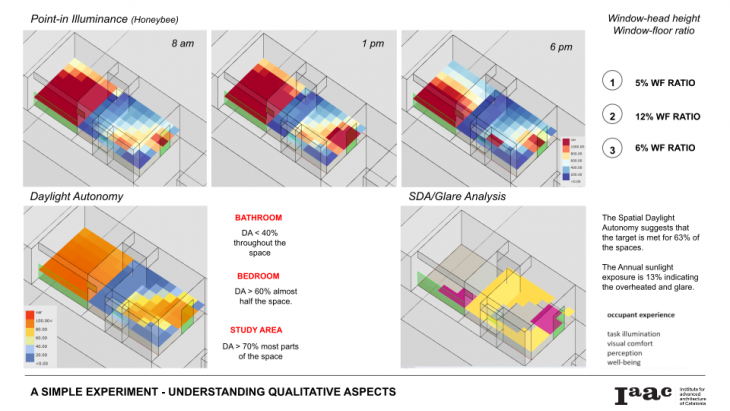
QUALITATIVE AND QUANTITATIVE ASSESSMENT|| Actually, multiple simulation and measurement tools are today available and used in building industry to assess daylight levels in a space. but are usually complex, very intrusive and may be only handled by experts. To easily perform measurements live in space, Saint- Gobain developed a wireless & lowcost setup for illuminance measurements which, has small footprint, ease installation.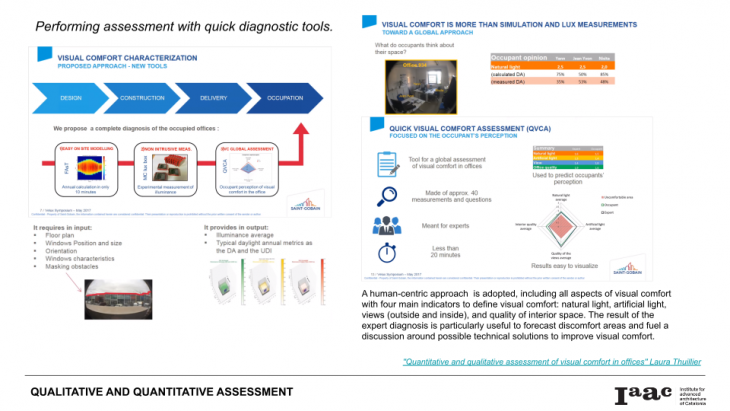
//NON-VISUAL ASPECTS AND APPLICATIONS:
VISUAL COMFORT DYNAMICS || Subjective aspects – study looks at the rainbow panaroma by Studio Olafur Eliasson, we observe certain change in thermal perception – blue vs red environment – experiment with varying color, glare or brightness. Another experiment at EPFL, Whether the lighting conditions affect where you look – not only task, understanding eye movement, we are attracted to brighter/darker areas. Deduce results.
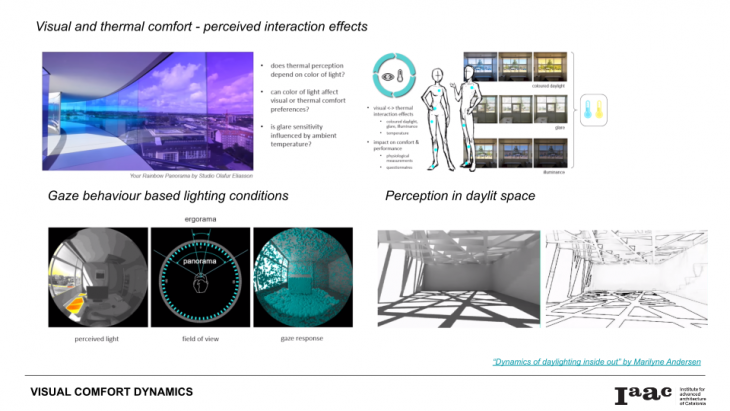
PERCEPTION AND SPACES || Can we determine level of excitement or calmness in various spaces. And what is the public opinion? So an online survey bassed on rating of various spaces in different skys. So, subjective to objective analysis. Lead to a rendering algorithm based on neighbouring pixels. Appreciate the variation of the scene over a period of time.
NON-VISUAL HEALTH ASPECTS OF DAYLIGHT || How to quantify the non-visual aspects? The photoreceptor in the eye is responsible for the biological cycles that define circadial cycles and other aspects of alertness, moods and performance. The spectral sensitivity is dynamic in response to light color. There is a threshold for direct effects that one needs during the day, the light exposure and the direction one looks is the blue range.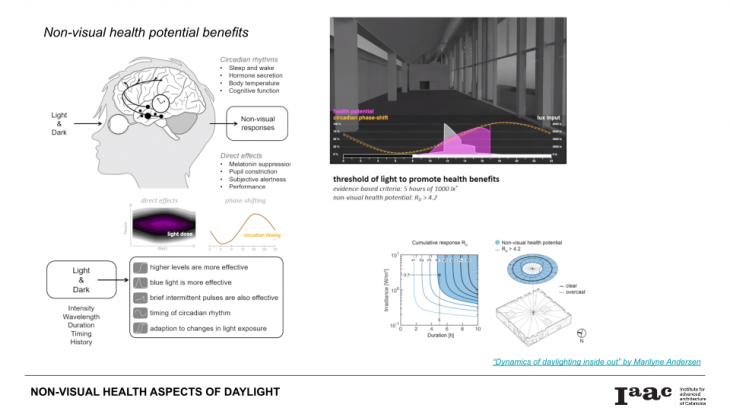
OCCUPANT CENTRIC DAYLIGHT SIMULATION || Practically applied – Take up an example, location in the building and view directions. Scenes, contrast, visual interest, excitement, health potential vary. Document studies and understand how the space performs as per the radar arrows. For single day or different days and at various levels, understand the results and then these subjective factors help in the architectural design of spaces.
//READINGS:
- “Ten questions concerning well-being in the built environment.” Building and Environment
- Dynamics of daylighting inside out by Marilyne Andersen
- Regenerative Design in Digital Practice by KADK
- Is daylight enough? Taking a holistic, human perspective by Peter Barrett
//CREDITS:
Impact of Daylight on Human Wellbeing and Architecture is a presentation of IAAC, Institute for Advanced Architecture of Catalonia developed at Master in Advanced Computation for Architecture & Design in 2020/21 by student: Harsh Shah lead faculty: Jane Burry guest faculty: Mehrnoush Latifi
